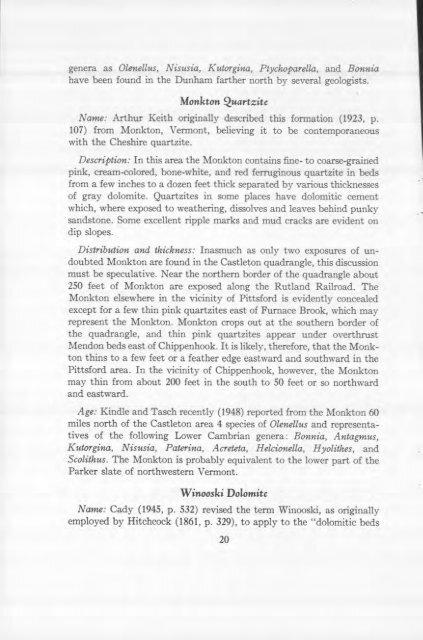STRATIGRAPHY AND STRUCTURE CASTLETON AREA VERMONT
STRATIGRAPHY AND STRUCTURE CASTLETON AREA VERMONT
STRATIGRAPHY AND STRUCTURE CASTLETON AREA VERMONT
Create successful ePaper yourself
Turn your PDF publications into a flip-book with our unique Google optimized e-Paper software.
genera as Olenellus, Nisusia, Kutorgina, Ptyclzoparella, and Bonnia<br />
have been found in the Dunham farther north by several geologists.<br />
Monkton Quartzite<br />
Name: Arthur Keith originally described this formation (1923, p.<br />
107) from Monkton, Vermont, believing it to be contemporaneous<br />
with the Cheshire quartzite.<br />
Description: In this area the Monkton contains fine- to coarse-grained<br />
pink, cream-colored, bone-white, and red ferruginous quartzite in beds<br />
from a few inches to a dozen feet thick separated by various thicknesses<br />
of gray dolomite. Quartzites in some places have dolomitic cement<br />
which, where exposed to weathering, dissolves and leaves behind punky<br />
sandstone. Some excellent ripple marks and mud cracks are evident on<br />
dip slopes.<br />
Distribution and thickness: Inasmuch as only two exposures of undoubted<br />
Monkton are found in the Castleton quadrangle, this discussion<br />
must be speculative. Near the northern border of the quadrangle about<br />
250 feet of Monkton are exposed along the Rutland Railroad. The<br />
Monkton elsewhere in the vicinity of Pittsford is evidently concealed<br />
except for a few thin pink quartzites east of Furnace Brook, which may<br />
represent the Monkton. Monkton crops out at the southern border of<br />
the quadrangle, and thin pink quartzites appear under overthrust<br />
Mendon beds east of Chippenhook. It is likely, therefore, that the Monkton<br />
thins to a few feet or a feather edge eastward and southward in the<br />
Pittsford area. In the vicinity of Chippenhook, however, the Monkton<br />
may thin from about 200 feet in the south to 50 feet or so northward<br />
and eastward.<br />
Age: Kindle and Tasch recently (1948) reported from the Monkton 60<br />
miles north of the Castleton area 4 species of Olenellus and representatives<br />
of the following Lower Cambrian genera: Bonnia, Antagmus,<br />
Kutorgina, Nisusia, Paterincz, Acreteta, Helcionella, Hyolithes, and<br />
Scolithus. The Monkton is probably equivalent to the lower part of the<br />
Parker slate of northwestern Vermont.<br />
Winoosbi Dolomite<br />
Name: Cady (1945, p. 532) revised the term Winooski, as originally<br />
employed by Hitchcock (1861, p. 329), to apply to the "dolomitic beds<br />
20













